 Facebook
Facebook
 X
X
 Instagram
Instagram
 TikTok
TikTok
 Youtube
Youtube
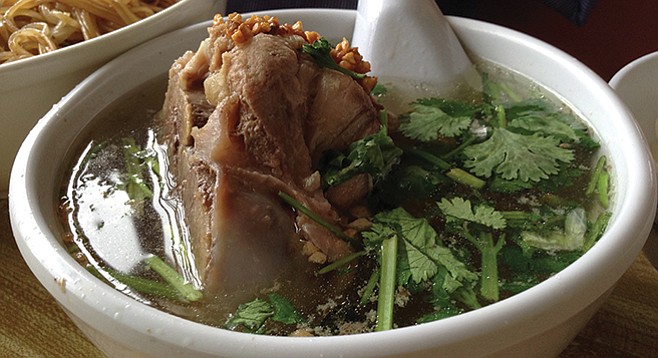
"I am Cambodian. I have some news to tell you. I want to go with you.”
This was the message my new friend Sinjin wrote out in big letters on a board on the roof of his rice mill by the Mekong River. Cambodia was going up in flames. He knew he was probably going to be killed if he didn’t escape.
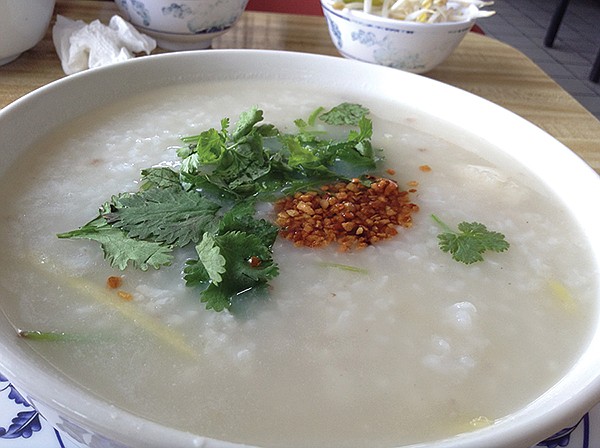
Luckily, an American patrol boat came barreling upstream, saw the sign, and waited till he swam out to them. He almost didn’t make it. One of the crew dove in and rescued him before he sank from exhaustion.
“And guess what? The man who rescued me, he lives in Chula Vista. I met him, 40 years later!”
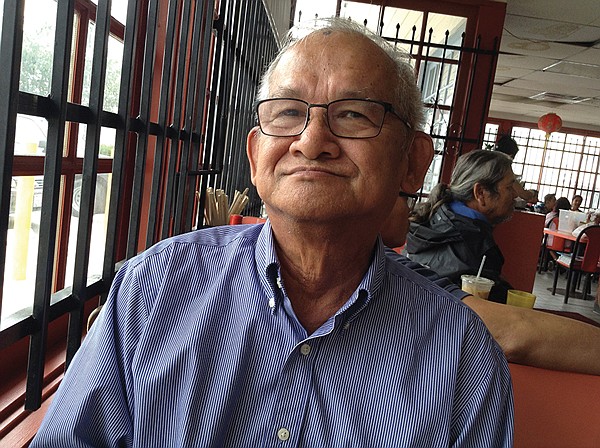
He’s telling me this across our breakfast table of noodles, bone soup, rice soup, and iridescent shark.
It’s a weekday morning. Sinjin and I are sitting in the orange Formica booths of the back room here at Trieu Chau up by 47th Street.
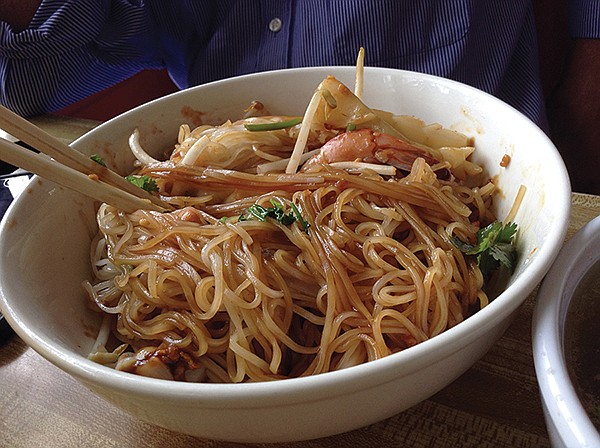
I love coming here, because you always find interesting guys talking and arguing about everything Cambodian. And I’ve always been hung up on brilliant, traumatized Cambodia.
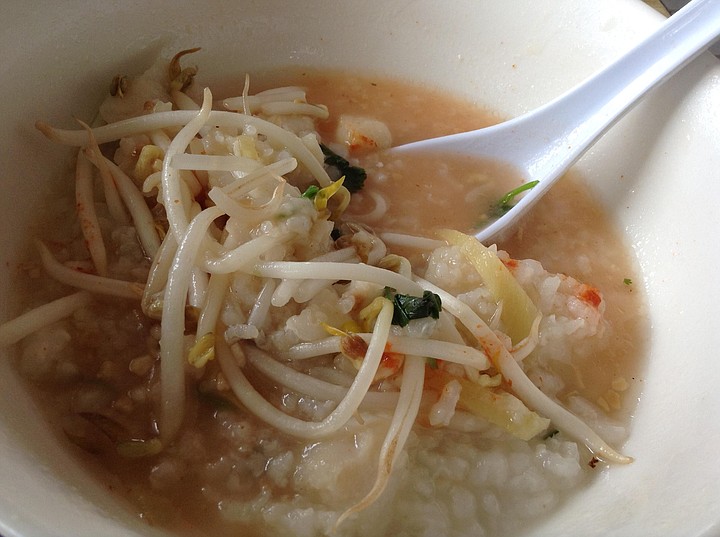
So, this morning I came in, looked for a seat, found the only spare table was piled with dishes from the previous customers.
“Please, come sit here,” says this gent in the next booth. I do, and pretty soon Sinjin and I are yacking like best buddies.
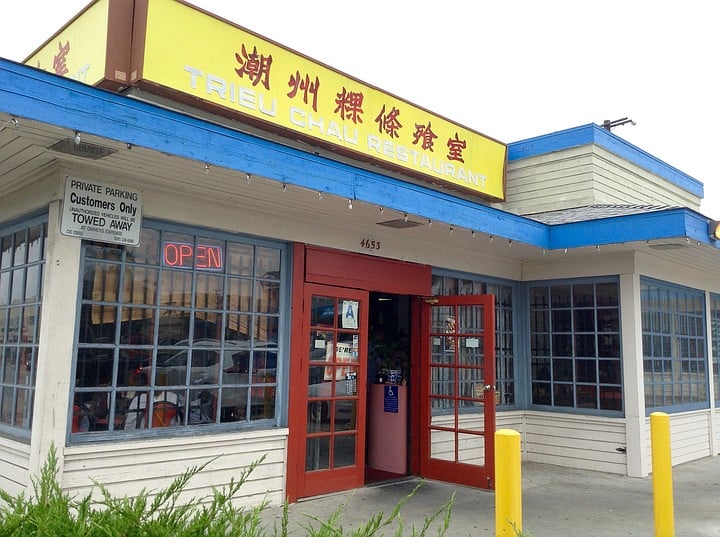
Until Kathy, the lady who runs this place with her family, arrives with his breakfast. Two bowls, one with rice noodles, the other with a giant bone in some soup. “I don’t like too much soup in my noodles,” says Sinjin. “This way I can put as much as I like in.”
You know this place is Cambodian from all the images of Angkor Wat, the famous temples that stick out of the jungle back there.
Right now, about ten in the morning, it’s full. How to get service? Technique is just to call out, “Kathy! I’m ready!” She’ll say, “I’m coming!” And you’d better be ready when she does.
I’m skimming through the menu right now. “Soup noodles and rice soups,” it says. “Extra-large bowl, $1 more. Noodles can be made dry with bone soup on side.” Then follows a long list of soups with everything from duck to fish fillet to pork-intestine soup with rice noodles. That costs $7. Sliced-beef soup with meatballs and noodles is $6.50. Wonton combination soup with egg noodles costs $7.25, and the pork combination rice soup congee is $6.25.
’Course, my all-time favorite breakfast dish is that, the congee, the jok, the long-cooked rice soup with different flavorings in it. Anything from pork to ginger to 1000-year-old eggs. In fact most of the menu looks more Chinese than anything else. Like chicken chop suey ($6.95) or Mo-Po-Tofu with black beans and pork ($6.95).
But there is definitely a Cambodian cuisine.
Like, when you talk fish to a Cambodian, you’re normally thinking freshwater fish. It’s a mostly inland country. With the mighty Mekong River and the Tonle Sap lake, they have a bigger array of fish than anywhere in the world except for the Amazon basin. Often enough, the way Cambodians present a soup, it kinda looks like a still life of an actual pond, with edible plants and veggies sticking out. Also, the food isn’t as spicy as, say, in Thailand. Yes, the Spanish and Portuguese brought spices from the New World (and peanuts), but the spices didn’t quite take in Cambodia. You always have the spice option with Khmer food, but usually with a bowl at the table for you to take if you want, not mixed in with the recipe.
So, for breakfast anyway, a piece of nom pang (French baguette) with pâté or eggs, plus a cup of coffee with sweetened condensed milk is what you’ll see most of. Nom pang is the Cambodian equivalent of the Vietnamese banh mi. I mean, they were both French colonies for a while, right?
But no, breakfast-wise, my fave is definitely jok, from the Chinese side of influence.
“Why don’t you have fish in it?” says Sinjin.
Uh, fish in the jok?
“We have swai,” says Kathy’s eldest son.
Oh, yes. The fish known as the iridescent shark. From the waters of the Mekong. Big. Mild flesh.
So that’s what I go for. Jok with swai. (“Seafood rice soup congee,” says the menu, “$7.”) When it comes steaming to my table with fresh cilantro and chopped peanuts on top, and vague yellow strips just under the surface — ginger? Green papaya? — I’m on it like a starving python.
It’s mild, but oh-so tasty, and with every spoonful I get a chunk of really tender iridescent shark. And the further down you go, the tastier the rice gloop gets.
You do read that people have worries about swai. About these big fish being raised in breeding ponds. But this one tastes fine, and it combines great with the ginger and seared garlic. And it is so filling.
Sinjin’s working on his big bone and the marrow it’s delivering. And combining his soup with the noodles in his other bowl. And he’s telling me about his incredible adventures back in the day in Cambodia when he was 20 and dealing with the Viet Cong, the Khmer Rouge, the Americans, and somehow surviving. And how he made it here, got to SDSU, got a teaching degree, and became an algebra teacher in middle school here, and has been going back to Cambodia setting up schools, lecturing — the guy’s unbelievable.
We pay up. Eight bucks each.
“So, Sinjin,” I say as we leave. “That message on the board that saved you. What was the news you had to tell the Americans?”
“Ah,” he says. “Not something I can tell. Even now. That’s how I survived. By being discreet.”
Hours: 8 a.m.–8 p.m., daily
Prices: Combination soup with rice noodles, $6; duck soup with rice noodles, $6.95; fish-ball soup with noodles, $6; pork combination rice soup, $5.60; seafood rice soup, $6.60; crispy tempura-battered fried shrimp, 6.95; beef chop suey, $6.95; Trieu Chau beef stew, $6.50; basil-chicken stir-fry, $7.25; five-spiced pork chops, $7; lemon-grass chicken, $7.25
Buses: 7, 10, 965
Nearest Bus Stop: University at 47th Street


"I am Cambodian. I have some news to tell you. I want to go with you.”
This was the message my new friend Sinjin wrote out in big letters on a board on the roof of his rice mill by the Mekong River. Cambodia was going up in flames. He knew he was probably going to be killed if he didn’t escape.

Luckily, an American patrol boat came barreling upstream, saw the sign, and waited till he swam out to them. He almost didn’t make it. One of the crew dove in and rescued him before he sank from exhaustion.
“And guess what? The man who rescued me, he lives in Chula Vista. I met him, 40 years later!”

He’s telling me this across our breakfast table of noodles, bone soup, rice soup, and iridescent shark.
It’s a weekday morning. Sinjin and I are sitting in the orange Formica booths of the back room here at Trieu Chau up by 47th Street.

I love coming here, because you always find interesting guys talking and arguing about everything Cambodian. And I’ve always been hung up on brilliant, traumatized Cambodia.

So, this morning I came in, looked for a seat, found the only spare table was piled with dishes from the previous customers.
“Please, come sit here,” says this gent in the next booth. I do, and pretty soon Sinjin and I are yacking like best buddies.

Until Kathy, the lady who runs this place with her family, arrives with his breakfast. Two bowls, one with rice noodles, the other with a giant bone in some soup. “I don’t like too much soup in my noodles,” says Sinjin. “This way I can put as much as I like in.”
You know this place is Cambodian from all the images of Angkor Wat, the famous temples that stick out of the jungle back there.
Right now, about ten in the morning, it’s full. How to get service? Technique is just to call out, “Kathy! I’m ready!” She’ll say, “I’m coming!” And you’d better be ready when she does.
I’m skimming through the menu right now. “Soup noodles and rice soups,” it says. “Extra-large bowl, $1 more. Noodles can be made dry with bone soup on side.” Then follows a long list of soups with everything from duck to fish fillet to pork-intestine soup with rice noodles. That costs $7. Sliced-beef soup with meatballs and noodles is $6.50. Wonton combination soup with egg noodles costs $7.25, and the pork combination rice soup congee is $6.25.
’Course, my all-time favorite breakfast dish is that, the congee, the jok, the long-cooked rice soup with different flavorings in it. Anything from pork to ginger to 1000-year-old eggs. In fact most of the menu looks more Chinese than anything else. Like chicken chop suey ($6.95) or Mo-Po-Tofu with black beans and pork ($6.95).
But there is definitely a Cambodian cuisine.
Like, when you talk fish to a Cambodian, you’re normally thinking freshwater fish. It’s a mostly inland country. With the mighty Mekong River and the Tonle Sap lake, they have a bigger array of fish than anywhere in the world except for the Amazon basin. Often enough, the way Cambodians present a soup, it kinda looks like a still life of an actual pond, with edible plants and veggies sticking out. Also, the food isn’t as spicy as, say, in Thailand. Yes, the Spanish and Portuguese brought spices from the New World (and peanuts), but the spices didn’t quite take in Cambodia. You always have the spice option with Khmer food, but usually with a bowl at the table for you to take if you want, not mixed in with the recipe.
So, for breakfast anyway, a piece of nom pang (French baguette) with pâté or eggs, plus a cup of coffee with sweetened condensed milk is what you’ll see most of. Nom pang is the Cambodian equivalent of the Vietnamese banh mi. I mean, they were both French colonies for a while, right?
But no, breakfast-wise, my fave is definitely jok, from the Chinese side of influence.
“Why don’t you have fish in it?” says Sinjin.
Uh, fish in the jok?
“We have swai,” says Kathy’s eldest son.
Oh, yes. The fish known as the iridescent shark. From the waters of the Mekong. Big. Mild flesh.
So that’s what I go for. Jok with swai. (“Seafood rice soup congee,” says the menu, “$7.”) When it comes steaming to my table with fresh cilantro and chopped peanuts on top, and vague yellow strips just under the surface — ginger? Green papaya? — I’m on it like a starving python.
It’s mild, but oh-so tasty, and with every spoonful I get a chunk of really tender iridescent shark. And the further down you go, the tastier the rice gloop gets.
You do read that people have worries about swai. About these big fish being raised in breeding ponds. But this one tastes fine, and it combines great with the ginger and seared garlic. And it is so filling.
Sinjin’s working on his big bone and the marrow it’s delivering. And combining his soup with the noodles in his other bowl. And he’s telling me about his incredible adventures back in the day in Cambodia when he was 20 and dealing with the Viet Cong, the Khmer Rouge, the Americans, and somehow surviving. And how he made it here, got to SDSU, got a teaching degree, and became an algebra teacher in middle school here, and has been going back to Cambodia setting up schools, lecturing — the guy’s unbelievable.
We pay up. Eight bucks each.
“So, Sinjin,” I say as we leave. “That message on the board that saved you. What was the news you had to tell the Americans?”
“Ah,” he says. “Not something I can tell. Even now. That’s how I survived. By being discreet.”
Hours: 8 a.m.–8 p.m., daily
Prices: Combination soup with rice noodles, $6; duck soup with rice noodles, $6.95; fish-ball soup with noodles, $6; pork combination rice soup, $5.60; seafood rice soup, $6.60; crispy tempura-battered fried shrimp, 6.95; beef chop suey, $6.95; Trieu Chau beef stew, $6.50; basil-chicken stir-fry, $7.25; five-spiced pork chops, $7; lemon-grass chicken, $7.25
Buses: 7, 10, 965
Nearest Bus Stop: University at 47th Street
Comments